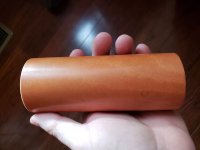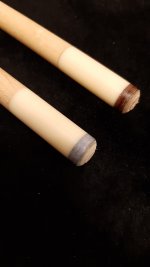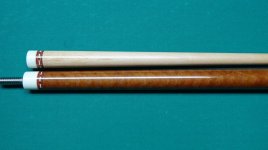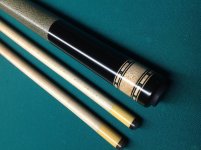You are using an out of date browser. It may not display this or other websites correctly.
You should upgrade or use an alternative browser.
You should upgrade or use an alternative browser.
Paper micarta vs linen micarta
- Thread starter vsmavs23
- Start date
Has anybody made their own, out of craft paper or card stock and resin?
I know of people who have for knife scales and pistol/revolver grips. Wonder if the homemade stuff would be up to the task of the type of stress a cue ferrule encounters repeatedly?
It would be if you used west system epoxy, I think.
But, it's just not worth the trouble.
It's easy for knife makers b/c they make them flat.
And they don't use lathe tools on them. They just use belt sanders.
For ferrules, you'd want them in rods or tubes. Not flat sheets.
If someone had the money and influence, they can call large micarta manufacturers and ask them to make their rods or tubes in white or off white.
Since, Atlas won't even do that , I think the demand for them on cues just does not offset the cost .
There products are made as electrical insulator . They sell tons of them in brown and not aesthetically perfect. They can't be bothered to get to make them in tight-woven white or off white paper micarta tubes and rods .
I do not know the type of paper used. One of the pieces of the formula lost to time.
It's not just paper, epoxy, and clamps. You need a press that has heating elements. The press needs to have at least a ton's worth of pressure to press sheets of paper in an epoxy bonding agent to end up thick enough for around 5/8ths for a ferrule. While pressing it needs heat, or to be baked, to "set". Start watching the videos of unique_micarta on Instagram. He did my custom order of paper micarta, trying to replicate Ivorite. He caters to knife makers. Just ask him for a batch, watch him laugh, then wait for the quote.
Cory Barnhart has my custom batch, as I was having him test it out and cut it for me. I'll see if I can stop by for a few pictures.
Nothing today can replicate Ivorite. At least, not that I've found in a decade of searching and having samples tested.
Thanks for clearing that up, I`ve just watched youtube videos of knifemakers making Micarta and they just use clamps and a mold, I kinda expected it to be more to it than that. Was the original Westinghouse rolled or in blocks?
Thanks for clearing that up, I`ve just watched youtube videos of knifemakers making Micarta and they just use clamps and a mold, I kinda expected it to be more to it than that. Was the original Westinghouse rolled or in blocks?
It was made both rolled and in blocks.
Here's a paper micarta insulator.


Last edited:
I just realized from these posts that i have had 3/4" or 5/8" thick pcs of this in the past. (of the linen). It has a reddish bark, but when machined, it is yellow inside, makes a very fine bright yellow dust. The linen in it is very fine weave. Used to use if for wear patterns for shaper work for long run small parts; and for machine way guides. Will have to look if there are any left hanging around on nails in the rafters.
Oh no, as if there was not enough pressure on NOS aircraft parts. I can just see cuemakers suddenly taking out Trade-a-Plane subscriptions and scouring them for old control run pulleys, guides, & stand-offs. I used to have handfull of linen standoffs and could not figure out what to use them for. Just about perfect ferule size. Though i think the linen was coarser than the "good stuff" shown.
smt
found in a war surplus store by a
cue maker in my are....had something to do with WWII landing craft
Oh no, as if there was not enough pressure on NOS aircraft parts. I can just see cuemakers suddenly taking out Trade-a-Plane subscriptions and scouring them for old control run pulleys, guides, & stand-offs. I used to have handfull of linen standoffs and could not figure out what to use them for. Just about perfect ferule size. Though i think the linen was coarser than the "good stuff" shown.
smt
The good yellow stuff.
Brown one is the current one you can get .
Different make-up.
Years ago, cue maker Mason H. talked to Norplex and made a volume order of melamine and paper micarta . The melamine was pitty. The paper micarta was really good and was not cheap. Somehow all that ended .
I still use his material to this day as there is not a better substitute .
It is much lighter than Juma but hits as hard.
Like these Mason Micarta from 2008. Still have it, still love it. :thumbup:

paper micarta
i worked in bert schrager's cue shop in the late 70s, 80s. he was one of the first to use
westinghouse paper micarta. that i know of anyway. he purchased it from a local
plastics sales company. it came in 1" thick sheets, 36" square. cutting and machining
it to 1" joint pieces and 1" length ferrules meant a lot of waste. the color was pale yellow
with no discernible grain, some mild specks, not really offensive. it would darken a bit
with age. schon and southwest used this material later on. that's my 2 cents.
i worked in bert schrager's cue shop in the late 70s, 80s. he was one of the first to use
westinghouse paper micarta. that i know of anyway. he purchased it from a local
plastics sales company. it came in 1" thick sheets, 36" square. cutting and machining
it to 1" joint pieces and 1" length ferrules meant a lot of waste. the color was pale yellow
with no discernible grain, some mild specks, not really offensive. it would darken a bit
with age. schon and southwest used this material later on. that's my 2 cents.
The engineer at International Paper who knew the composition of "old yellow" micarta, said the paper was paper grocery bags.
What kind of paper was used?
The engineer at International Paper who knew the composition of "old yellow" micarta, said the paper was paper grocery bags.
Thank you. Gave you some greens!
i worked in bert schrager's cue shop in the late 70s, 80s. he was one of the first to use
westinghouse paper micarta. that i know of anyway. he purchased it from a local
plastics sales company. it came in 1" thick sheets, 36" square. cutting and machining
it to 1" joint pieces and 1" length ferrules meant a lot of waste. the color was pale yellow
with no discernible grain, some mild specks, not really offensive. it would darken a bit
with age. schon and southwest used this material later on. that's my 2 cents.
Thank you for chiming in. It's great when someone with first-hand experience shows up.
Your remarks on appearance are spot on with freshly cut (new surface) pieces.
Greens sent.
It was made both rolled and in blocks.
Here's a paper micarta insulator.
View attachment 512205
View attachment 512206
You can make a cue out of that thing.
It's tough finding a good piece to turn into cues these days.
Attachments
You can make a cue out of that thing.
It's tough finding a good piece to turn into cues these days.
Damn, Joey! That's beautiful!
That's a pretty cue, Joey!
That is also what Formica is made of. But they must use a different resin. Formica is craft (might be Kraft) paper laminate (the name for paper bag material) and phenolic resin, with a melamine face that is the pattern or color layer.
smt
The engineer at International Paper who knew the composition of "old yellow" micarta, said the paper was paper grocery bags
That is also what Formica is made of. But they must use a different resin. Formica is craft (might be Kraft) paper laminate (the name for paper bag material) and phenolic resin, with a melamine face that is the pattern or color layer.
smt
That's a pretty cue, Joey!
That is also what Formica is made of. But they must use a different resin. Formica is craft (might be Kraft) paper laminate (the name for paper bag material) and phenolic resin, with a melamine face that is the pattern or color layer.
smt
Thanks. I did not know formica was paper based too.
This is my own beat-up personal player now.
Cored with bloodwood.
I have another one in the making I'm coring with BRW laminate.
Attachments
i worked in bert schrager's cue shop in the late 70s, 80s. he was one of the first to use
westinghouse paper micarta. that i know of anyway. he purchased it from a local
plastics sales company. it came in 1" thick sheets, 36" square. cutting and machining
it to 1" joint pieces and 1" length ferrules meant a lot of waste. the color was pale yellow
with no discernible grain, some mild specks, not really offensive. it would darken a bit
with age. schon and southwest used this material later on. that's my 2 cents.
Early South West with Westinghouse micarta...
Attachments
Early South West with Westinghouse micarta...
Love those creamcicle ferrules!
Wanted to bump this old thread, as I've recently been in a "discussion" on Facebook regarding this material and have since performed my due diligence of research. I have spoken to some of my resources new and old, including knife makers and plastics guys; and also performed chemical research with some sites I used in obtaining my undergrad chemistry degree.
The topic of Asbestos keeps surfacing when it comes to micarta and cue people. I can say, micarta was made with a substrate of asbestos, and was used in many industrial capacities. From the research I've performed, color played no roll in its industrial use. It was added as a fire/heat inhibitor. It would have looked like what asbestos pipe insulation looks like, today - dull grey, white, fibrous, and pliable. The micarta used in pool cues was part of the decorative lines. Color was a major roll of the decoratives. Green, brown, yellow, ivory, blue, red made with substrates of linen, paper, canvas, cotton, burlap, wood pulp etc.
Micarta, in as simplest terms as possible, is resin, substrate, pressure, & heat. In the early days the resin was Phenol Formaldehyde based - hence Phenolic. Many different formulations were used/made in the decorative lines and scooped up by cue guys as an alternative to ivory. As an alternative to ivory one did not want the heavy substrates of linen, canvas, or cotton, as the substrates were clearly visible. So, paper decoratives were chosen. BTW, wood pulp micarta is Bakelite, made by Marbelite (Palmer ferrules). Paper decoratives came in ivory, antique ivory, and ivorite. Ivorite being the highest grade, taking the highest polish & luster when finished.
Now, back to Phenol Formaldehyde. In chemistry, phenol cannot completely convert when condensed with formaldehyde. Finished condensates always contain some amount of free phenol. When free phenol interacts with UV light and/or heat, oxidation occurs causing the yellowing effect over time.
Lastly, the only micarta could have been used by pool guys and that could have contained asbestos would be FR2/3/4. "FR" denoting the fire rating. "FR-2 (Flame Resistant 2) is a NEMA designation for synthetic resin bonded paper, a composite material made of paper impregnated with a plasticized phenol formaldehyde resin, used in the manufacture of printed circuit boards. Its main properties are similar to NEMA grade XXXP (MIL-P-3115) material, and can be substituted for the latter in many applications." It's still paper micarta, but MAY have contained asbestos as a fire inhibitor. FR-2 was also made without asbestos.
A cue maker would have to find or order a piece of FR big enough, prior to the mid 1970s, and HOPE is came in an uniform off-white color. This was not a decorative, and color never mattered.
If you're still with me, thank you for reading. South West, Schon, Schrager, JW and any other cue maker using micarta in the good 'ol days, was using ivory paper micarta. Period.
Josh
The topic of Asbestos keeps surfacing when it comes to micarta and cue people. I can say, micarta was made with a substrate of asbestos, and was used in many industrial capacities. From the research I've performed, color played no roll in its industrial use. It was added as a fire/heat inhibitor. It would have looked like what asbestos pipe insulation looks like, today - dull grey, white, fibrous, and pliable. The micarta used in pool cues was part of the decorative lines. Color was a major roll of the decoratives. Green, brown, yellow, ivory, blue, red made with substrates of linen, paper, canvas, cotton, burlap, wood pulp etc.
Micarta, in as simplest terms as possible, is resin, substrate, pressure, & heat. In the early days the resin was Phenol Formaldehyde based - hence Phenolic. Many different formulations were used/made in the decorative lines and scooped up by cue guys as an alternative to ivory. As an alternative to ivory one did not want the heavy substrates of linen, canvas, or cotton, as the substrates were clearly visible. So, paper decoratives were chosen. BTW, wood pulp micarta is Bakelite, made by Marbelite (Palmer ferrules). Paper decoratives came in ivory, antique ivory, and ivorite. Ivorite being the highest grade, taking the highest polish & luster when finished.
Now, back to Phenol Formaldehyde. In chemistry, phenol cannot completely convert when condensed with formaldehyde. Finished condensates always contain some amount of free phenol. When free phenol interacts with UV light and/or heat, oxidation occurs causing the yellowing effect over time.
Lastly, the only micarta could have been used by pool guys and that could have contained asbestos would be FR2/3/4. "FR" denoting the fire rating. "FR-2 (Flame Resistant 2) is a NEMA designation for synthetic resin bonded paper, a composite material made of paper impregnated with a plasticized phenol formaldehyde resin, used in the manufacture of printed circuit boards. Its main properties are similar to NEMA grade XXXP (MIL-P-3115) material, and can be substituted for the latter in many applications." It's still paper micarta, but MAY have contained asbestos as a fire inhibitor. FR-2 was also made without asbestos.
A cue maker would have to find or order a piece of FR big enough, prior to the mid 1970s, and HOPE is came in an uniform off-white color. This was not a decorative, and color never mattered.
If you're still with me, thank you for reading. South West, Schon, Schrager, JW and any other cue maker using micarta in the good 'ol days, was using ivory paper micarta. Period.
Josh
Wanted to bump this old thread, as I've recently been in a "discussion" on Facebook regarding this material and have since performed my due diligence of research. I have spoken to some of my resources new and old, including knife makers and plastics guys; and also performed chemical research with some sites I used in obtaining my undergrad chemistry degree.
The topic of Asbestos keeps surfacing when it comes to micarta and cue people. I can say, micarta was made with a substrate of asbestos, and was used in many industrial capacities. From the research I've performed, color played no roll in its industrial use. It was added as a fire/heat inhibitor. It would have looked like what asbestos pipe insulation looks like, today - dull grey, white, fibrous, and pliable. The micarta used in pool cues was part of the decorative lines. Color was a major roll of the decoratives. Green, brown, yellow, ivory, blue, red made with substrates of linen, paper, canvas, cotton, burlap, wood pulp etc.
Micarta, in as simplest terms as possible, is resin, substrate, pressure, & heat. In the early days the resin was Phenol Formaldehyde based - hence Phenolic. Many different formulations were used/made in the decorative lines and scooped up by cue guys as an alternative to ivory. As an alternative to ivory one did not want the heavy substrates of linen, canvas, or cotton, as the substrates were clearly visible. So, paper decoratives were chosen. BTW, wood pulp micarta is Bakelite, made by Marbelite (Palmer ferrules). Paper decoratives came in ivory, antique ivory, and ivorite. Ivorite being the highest grade, taking the highest polish & luster when finished.
Now, back to Phenol Formaldehyde. In chemistry, phenol cannot completely convert when condensed with formaldehyde. Finished condensates always contain some amount of free phenol. When free phenol interacts with UV light and/or heat, oxidation occurs causing the yellowing effect over time.
Lastly, the only micarta could have been used by pool guys and that could have contained asbestos would be FR2/3/4. "FR" denoting the fire rating. "FR-2 (Flame Resistant 2) is a NEMA designation for synthetic resin bonded paper, a composite material made of paper impregnated with a plasticized phenol formaldehyde resin, used in the manufacture of printed circuit boards. Its main properties are similar to NEMA grade XXXP (MIL-P-3115) material, and can be substituted for the latter in many applications." It's still paper micarta, but MAY have contained asbestos as a fire inhibitor. FR-2 was also made without asbestos.
A cue maker would have to find or order a piece of FR big enough, prior to the mid 1970s, and HOPE is came in an uniform off-white color. This was not a decorative, and color never mattered.
If you're still with me, thank you for reading. South West, Schon, Schrager, JW and any other cue maker using micarta in the good 'ol days, was using ivory paper micarta. Period.
Josh
Just to be clear, are you saying they were using the "paper decoratives" in the "Ivory" color version of the three colors you described? (Ivory, Antique Ivory, or Ivorite)
If so, earlier in the thread you said "the good stuff" was the Ivorite version?
Can you clear that up...:thumbup:



